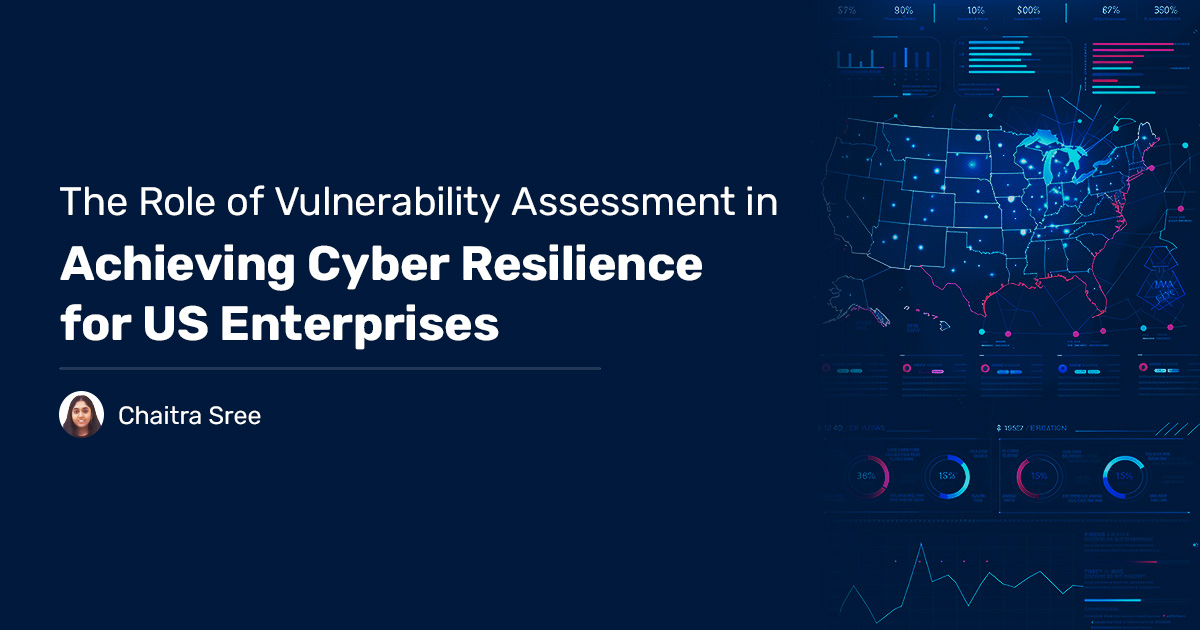According to reports, the US ranks the top-most among other countries on the list of being a target for attackers. It faces almost 65% of cyberattacks compared to all the other industries in a year. As one of the world’s largest economies, it hosts numerous multinational corporations and critical infrastructure systems that are attractive to cybercriminals seeking financial gain or disruption.
A wide variety of attacks are being exploited in the US, from phishing attacks to intellectual property theft to state-sponsored attacks. As attacks are only going to increase, enterprises should develop the capability to withstand and recover from such incidents. To stay protected, alongside vulnerability assessment, enterprises should also consider cyber resilience. By combining both these factors, enterprises will be well-prepared for cyberattacks. Let’s discuss in detail how vulnerability assessment can be combined and its essential role in US enterprise cybersecurity.
Understanding Cyber Resilience
What is Cyber Resilience?
Cyber resilience is an enterprise’s ability to prepare for, respond to, and recover from cyber incidents while maintaining continuous business operations. It encompasses a proactive approach to risk management, incorporating preventive measures and response and recovery strategies.
Here are a few key components that are usually found in cyber resilience plans:
- Risk Management: Identifying and mitigating potential threats.
- Incident Response: Establishing plans for addressing breaches.
- Recovery Planning: Ensuring business continuity in the face of cyber disruptions.
The Importance of Resilience
As cyber threats evolve, resilience becomes essential for safeguarding sensitive information and maintaining trust with customers and stakeholders. A resilient enterprise can adapt to disruptions, minimizing impact and ensuring a quicker return to normal operations.
But is cyber resilience alone enough?
Before we answer that question, let’s understand what vulnerability assessment does.
Importance of Vulnerability Assessment & Its Types
What is Vulnerability Assessment?
Vulnerability assessment involves identifying, assessing, and prioritizing vulnerabilities in an enterprise’s IT network. It is a critical step in protecting networks from potential threats, and it can also provide insights into potential weaknesses that could be exploited by cyber attackers.
Current Gap of Vulnerability Assessment in the US
Vulnerability assessments in the U.S. face several gaps and challenges:
- Often, IT network data resides in isolated systems, making comprehensive assessments difficult.
- The fast pace of technological advancement will make their existing assessment methodologies outdated, leaving gaps in identifying new risks.
- Different industries must adhere to many compliance standards. A lack of uniform standards can lead to inconsistent assessment practices and results.
- Social engineering attacks play a crucial role in the US due to the population
- Increasing reliance on third-party vendors creates risks that are challenging to assess and manage.
Types of Vulnerability Assessment
1. Network Vulnerability Assessment: Focuses on identifying vulnerabilities in network infrastructure, including servers, routers, and switches.
2. Web Application Vulnerability Assessment: Examines web applications for security weaknesses that could be exploited by attackers.
3. Host-Based Vulnerability Assessment: Involves scanning individual systems for vulnerabilities, including operating systems and installed software.
4. Database Vulnerability Assessment: Scans databases to detect risks, misconfigurations and exposures.
Let’s now understand step-by-step how this vulnerability assessment works.
Vulnerability Assessment Process
The vulnerability assessment process typically follows these steps:
1. Planning and Scope Definition: Determine the scope of the assessment, including systems to be tested and the assessment methodology.
2. Information on IT assets: Collecting data about the systems, networks, and applications that are present in the IT.
3. Detecting risks: Scanning the entire IT to identify vulnerabilities that cause harm to the network.
4. Assessing risks: Analyse the results of the scan to identify and prioritize vulnerabilities based on severity levels.
5. Reporting: Document findings, including recommendations for remediation.
6. Remediation and Reassessment: Implement fixes for identified vulnerabilities and conduct follow-up assessments to ensure effectiveness.
Now that we know both about vulnerability assessment and cyber-resilience, is it enough to implement only either one of them?
Why Should we Integrate Vulnerability Assessment and Cyber Resilience?
Since cyberattacks are skyrocketing in the US, it becomes extremely important for enterprises to Integrate vulnerability assessments into a cyber resilience strategy.
Taking factors of identifying, assessing, and remediating vulnerabilities from vulnerability assessments and the incident response plan from cyber-resilience, Enterprises will definitely witness advancements in their security posture.
- Proactive Measures: By applying all the measures for both factors, enterprises can stay ahead of potential threats by continually updating their defenses.
- Informed Decision-Making: IT/ security admins or even C-suits can make more informed decisions by utilizing the vulnerability data and can effectively allocate resources for security measures.
- Continuous Improvement: Regularly assessing the strategy will enhance security, and improvements in the current process can be considered.
What Can U.S. Enterprises Gain After Implementing Vulnerability Assessment?
Implementing the integrated approach yields numerous benefits for U.S. enterprises, including:
- Enhanced Security Posture: Regular and advanced techniques lead to a stronger overall security framework.
- Regulatory Compliance: Continuous monitoring and assessment, which are part of compliance mandates, make achieving compliance easier.
- Minimized Attack Surface: Identifying and addressing vulnerabilities and risks reduces the likelihood of successful cyber-attacks.
- Increased Trust: Demonstrating a commitment to cybersecurity can enhance customer and stakeholder trust.
Conclusion
In an era where cyber threats are a constant reality, vulnerability assessment plays a vital role in achieving cyber resilience for U.S. enterprises. By understanding their vulnerabilities and taking proactive steps to address them, enterprises can not only protect their assets but also ensure a quicker recovery from incidents. The integration of vulnerability assessment into a comprehensive cyber resilience strategy is not just a best practice; it’s an essential component of modern business operations. As threats evolve, so do our defenses, starting with a robust vulnerability assessment framework.

